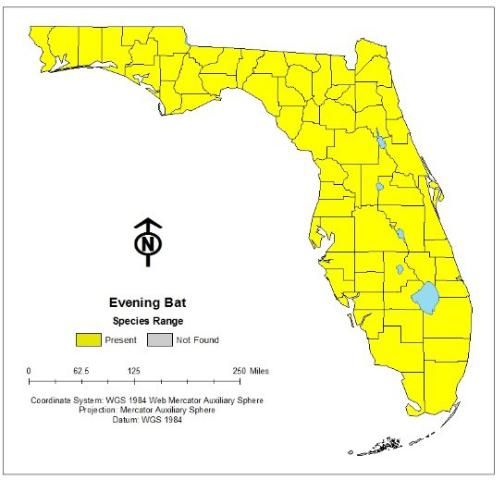The evening bat is a relatively small, forest-dwelling bat. Evening bats' wing spans are approximately 10 inches, and they typically weigh as much as 1 or 2 US quarters (6–12 g). They are dark brown to yellow with short brown ears and a broad, hairless muzzle (Figure 1). This species looks like the big brown bat but is noticeably smaller.

Credit: Merlin Tuttle, Merlin Tuttle's Bat Conservation

Evening bats are found throughout the eastern United States. They occur everywhere in Florida except for the Keys, and their range extends into Pennsylvania, southern Michigan, and south-central Texas.
Evening bats typically emerge from their roost (the place where they sleep during the day) shortly after sunset, and can be seen flying low and slow over a variety of habitats such as open fields, forest edges, and water. Evening bats roost in natural structures such as hollow trees and crevices and underneath tree bark. They also roost in or under man-made structures such as the undersides of bridges, buildings, caps on top of utility poles, folded patio umbrellas, and bat houses. The evening bat is the second most common species in Florida to inhabit bat houses, following the Brazilian free-tailed bat.
Evening bats are quite tolerant of other species. They often share roosts with Brazilian free-tailed bats and southeastern myotis.
Evening bats form small colonies, or groups, that range from a few to as many as 100 individuals. In autumn, evening bats in their northern range will migrate south to warmer climates. Evening bats in Florida tend to migrate shorter distances because much of the state has warm weather throughout the year.
In the summer, females form maternity colonies (birthing sites) in hollow trees or old buildings. Females give birth to two pups between April and May. Evening bat pups stop drinking their mothers' milk and begin to eat insects when they are 6–9 weeks old.
Mature evening bats, like all of Florida's resident bats, are insectivorous, meaning they only eat insects. Their diet includes beetles, moths, and other small flying insects.
Distinguishing the Evening Bat from Similar Florida Bat Species
Evening bats are relatively small brown bats, approximately 2.3 inches (49–67 mm) from head to rump. The wings, ears, and snout are dark brown and unfurred.
Read below to determine how to differentiate evening bats from other similar species found in Florida.
Evening Bat
- Fur is brown to dark brown on the back and buff to tan on the stomach.
- Ears, muzzle, and wing membranes are dark brown and unfurred.
- Evening bats resemble big brown bats but are much smaller.
- Bats roost in fairly small groups numbering up to 100 individuals in tree cavities, beneath tree bark, in concrete bridges, beneath caps on top of utility poles, in folded patio umbrellas, in houses, and in bat houses.
- Bats may share roosts with Brazilian free-tailed bats and southeastern myotis bats.
Big Brown Bat
- Fur is silky, dark brown to red or golden brown on the back, and lighter on the stomach.
- Ears, muzzle, and wing membranes are dark brown and unfurred.
- Body is fairly large, approximately 2.5 inches (53–81 mm) and weighs 11–23 grams (less than 1 ounce).
- Bats roost in tree cavities, attics, picnic or outdoor shelters, concrete bridges, and bat houses.
- They forage year-round in Florida except on very cold nights.
- Big brown bats are fairly common from the Panhandle to central Florida but seldom found in the southern 1/3 of the state.
Southeastern Myotis
- Fur ranges in color from gray to brown to reddish on the back and buff to tan on the stomach.
- Wing membranes are dark brown, and the muzzle is mostly furred.
- The base of each wing is attached to the inner toe of each foot.
- Long hairs between the toes extend past the claws.
- The body is small, approximately 2 inches (48–53 mm) from nose to rump.
- Bats roost in colonies ranging from 100 to 10,000 in caves, tree cavities, concrete bridges and culverts, houses, and bat houses.
Additional Information
Florida Fish and Wildlife Conservation Commission. Living with bats.
Marks, C. S. and G. E. Marks. Bats of Florida. 2006. University Press of Florida. Gainesville, Fl. 176 pp.
Ober, H. K., M. B. Main, and G. M. Allen. 2004. Bats of Florida. WEC186. Gainesville: University of Florida, Institute of Food and Agricultural Sciences. https://edis.ifas.ufl.edu/publication/uw203
Ober, H. K. and F. J. Mazzotti. 2008. Conservation of Bats in Florida. WEC247. Gainesville: University of Florida, Institute of Food and Agricultural Sciences. https://edis.ifas.ufl.edu/publication/uw291
Ober, H. K. 2008. Effective Bat Houses for Florida. WEC246. Gainesville: University of Florida, Institute of Food and Agricultural Sciences. https://edis.ifas.ufl.edu/uw290
Ober, H. K. 2008. Insect Pest Management Services Provided by Bats. WEC245. Gainesville: University of Florida, Institute of Food and Agricultural Sciences. https://edis.ifas.ufl.edu/publication/uw289
Wisely, S. M., and H. K. Ober. 2015. Facts about Wildlife Diseases: Rabies. WEC239. Gainesville: University of Florida, Institute of Food and Agricultural Sciences. https://edis.ifas.ufl.edu/uw282